
Window Kindergarten
In the last post about KWinFT's Windowing Revolution I promised follow-up articles with detailed explorations of two elements of that revolution, which due to their complexity deserve such.
One of them was a new way how Wayland subsurfaces are managed inside KWinFT. Accompanying the 5.21 release of KWinFT this week, which was made available in sync with the KDE Plasma release, let me live up to my promise and start with an exploration of that.
But since even this topic alone is overly complex with a lot of windowing history behind it, we will split it up further and in this first article only look at subsurfaces and related concepts from a high level but without yet looking at the new and improved implementation in KWinFT.
On a high level the notions we are dealing with can always be interpreted as some form of parent-child relation between windows, on Wayland just as much as on X11. We will see that this is a very powerful mental model.
 Childhood Legacy
Childhood Legacy
The idea that a window can have children is old. X11 has known that for a long time. It is in fact a central concept in the protocol and what it comes down to is a single, global window tree.
This tree, stored in the X Server, forms a simple hierarchical structure of all windows starting with a generic root window at the top while every child window is contained inside its parent. This means also that the root window spans the whole visible area over all screens. Child windows on the other hand can be further partitioned, moved and resized, ordered and even switch nodes in the tree.
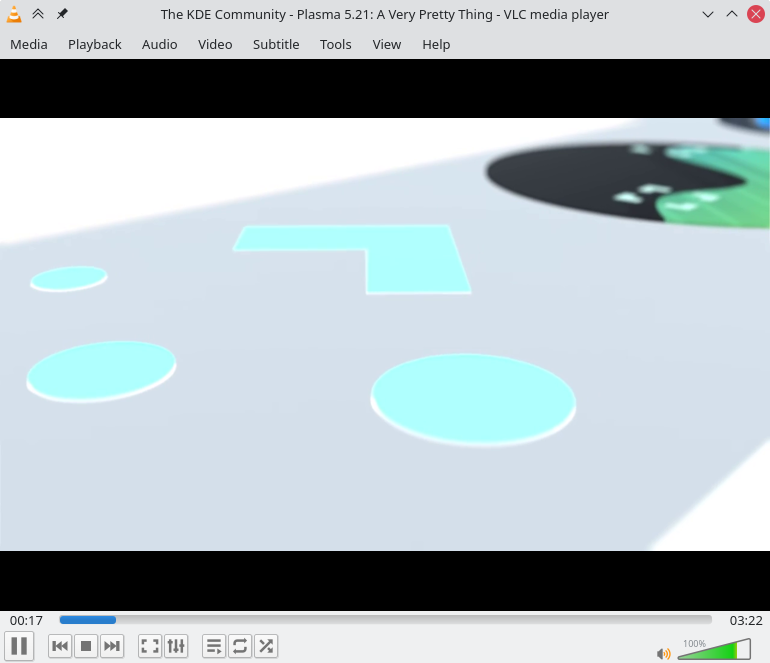
VLC playing a video in another child window.
While the details of that windowing logic can become complex very quickly, I think the general idea behind the window tree itself is simple to grasp. You still might want to read the window tree chapter in Xplain to get a feel for it.
Now as you can imagine such a hierarchical structure of windows is not something only X11 employs. But before we come to Wayland, there is one more relation between windows on X11, similar to the parent-child relation in the window tree, that we should explore.
 Distant Relatives
Distant Relatives
A second concept of window relation in X11, is that of transient windows. It is similar to the parent-child relation in the global window tree, but while an X11 window always has a parent, with the exception of the root window at the top of the tree, so in particular is a child to this parent, transient windows are much less often encountered in the wild.
 Jumping the Tree
Jumping the Tree
The parent-child relation in the window tree is simple to understand. Transient windows break this model up in some way and build links between windows across different branches of the tree. That sounds complicated, and indeed it sometimes is. In fact I would argue already their name is misleading.
But before coming to that, let us first hold onto what is unambiguous. Windows that are direct children of the root window are special, they are often called toplevel windows because of that. And a child of such a window is obviously – per this definition – not a toplevel window.
Transient windows in general come as toplevel windows. Seen as part of the window tree, they are siblings of the window they are transient for.
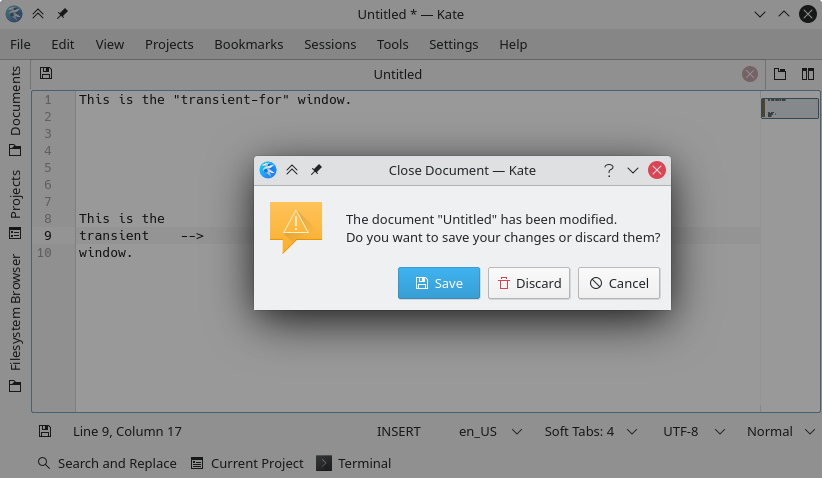
Dialog as a transient window for the Kate window.
Typical examples of such are dialog windows, shown when your application asks you if you really want to do what you just tried to do. The client sets such a helper-window as a transient for the main window of the application.
The window manager still paints decorations around the transient window and you can move it by grabbing its window bar, but the window manager normally ensures that it can't be stacked below the window, which the window is a transient for. And if for example you switch the main application window to a different virtual desktop, the transient often follows the main window to that other desktop. This is how KWinFT does it.
 What They Are Transient For
What They Are Transient For
You may have noticed that I've used in the last paragraphs an awful lot the word construct "transient for".
What defines a window to become transient is not specified in the X11 protocol itself, but in the Inter-Client Communication Conventions Manual (ICCCM) in the form of a window property with this very name.
This name feels weird, doesn't it?
Let's try to understand what it means:
A window W2 has the WM_TRANSIENT_FOR property set to another window W1
if window W2 is a transient window for window W1.
For example when a file explorer opens a dialog to ask you for a new name for a directory that it wants to create, the dialog window is W2 and the file explorer window, that was there before, is W1.
That we call such a relation at all transient comes according to Wikipedia from W2 only existing as long as W1 exists. But child windows in the window tree are also only mapped, i.e. visible and by that existing in practice, as long as their parents are mapped. So why are they not called transient windows too?
In theory also nothing is forcing the user to close the dialog and instead to keep it around forever. In the case of a dialog that wouldn't make much sense from a practical viewpoint, but there are other clients with permanent transient windows like a Plasma applet when being "pinned" to stay open. The bottom line is that this name feels wrong.
And then its indirect nature! The "transient for" property names a window that the other window with that property is the transient for. That is difficult to understand because we usually don't name things by what another thing does to it.
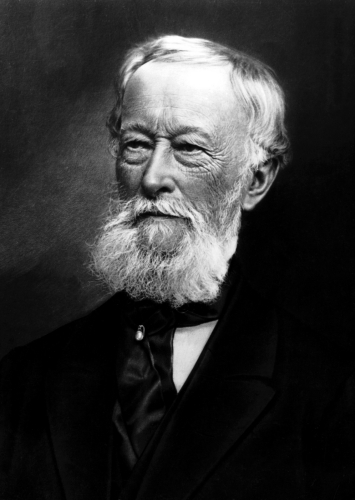
Alfred Krupp, an important "work for" in the 19th century.
For example we don't name the owner of a company the "work for" if there are employees working in that company. We say instead that the owner is an employer, what comes from what the owner is doing to the employees and not the other way around.
But besides the weird naming scheme the technicalities are clear: we set the property to another window and by that the relation is established.
As you can set the property only once per window, but for many windows to the same window, the relation is one-to-many. That feels natural as it reminds us of a single node with its children in a tree structure. But the X ecosystem has of course means to generalize that concept so it becomes far more difficult to understand.
 Group Transients
Group Transients
Complexity rises with the introduction of so-called group transients. They are defined by the Extended Window Manager Hints (EWMH) specification in the most ridiculous way, what warrants a direct quotation:
If the WM_TRANSIENT_FOR property is set to None or Root window, the window should be treated as a transient for all other windows in the same group. It has been noted that this is a slight ICCCM violation, but as this behavior is pretty standard for many toolkits and window managers, and is extremely unlikely to break anything, it seems reasonable to document it as standard.
— EWMH
This makes transient relations between windows much more complicated, as a window might not be transient for a single other window but for many. With that window transiency is a many-to-many relation.
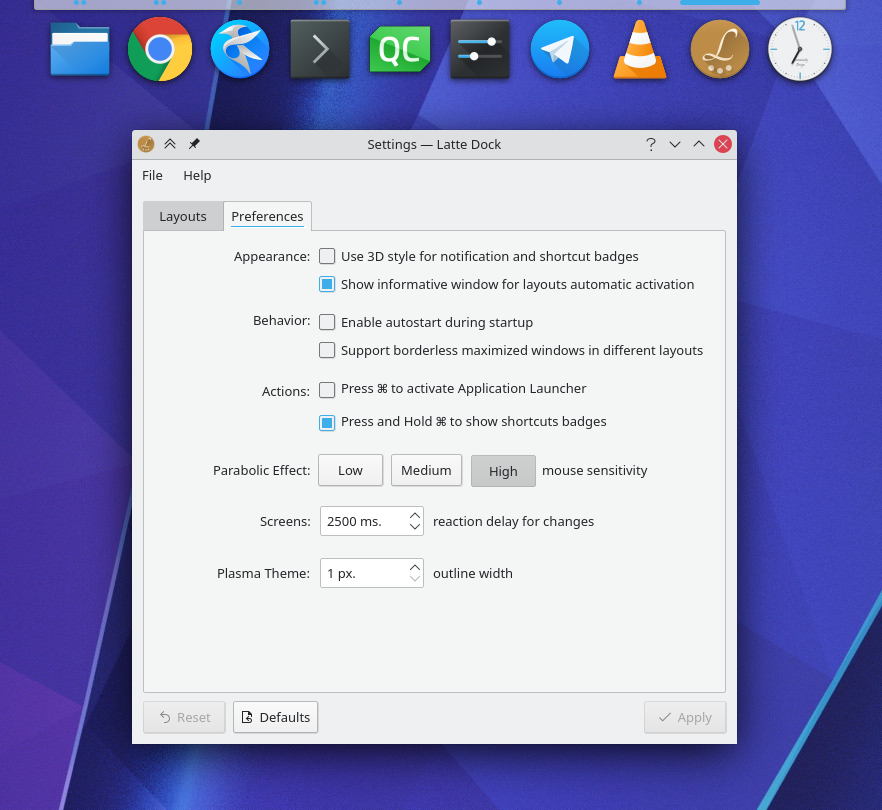
A rare example of a group transient: Latte Dock's settings window.
I have yet to see a use case for group transients that could not also be solved with normal transients, but as some X11 clients expect group transients to be a thing, KWinFT needs to support them.
While this was done in the past in KWin in a separate fashion basically doubling the implementation cost, the recent windowing refactor has unified it under a single mechanism together with usual X11 transients and even all kinds of child windows on Wayland.
But before we finally shift our attention over to Wayland I have to get some words off my chest about the naming of things.
 Nomenclature in Perpetuity
Nomenclature in Perpetuity
Naming things is difficult. Especially technical minded people often underestimate the challenge just as much as its importance. In contrast humanities has a long tradition of describing and criticizing concepts of notions and language.
The importance is emphasised in the German language, where the word for "notion" is "Begriff", what is related to "begreifen", meaning to understand something. "Etwas auf den Begriff bringen" means not only to find a name for something but to understand it.
When we name something we should remember that, not only for ourselves, but also for other people who have to understand and memorize the terminology we defined. This is important for open source projects that rely on voluntary contributions just as much as for companies as it lowers costs when onboarding new employees.
But that doesn't mean a once established nomenclature has to be perfect. On the opposite I would say that is impossible and as time moves on we should verify that the terminology still make sense, and if not revise it.
The reality though is that this is not often done systematically. Instead the terminology stays frozen in time but its meaning shifts naturally over time. That also is not necessarily an issue but one should be aware of it and if the gap between intuitive and original meaning of a notion becomes too wide one must consider to redefine or at least annotate it. And the notions of child windows and transients are good examples of that.
 Transiently Incomprehensible
Transiently Incomprehensible
We learned above what it means for a window to be a transient for another window. This included a short discussion why "transient for" is a silly name for the window which is not the transient in this relation. But that does not answer the question why such an unusual naming scheme was used.
The real story behind it probably only few people alive can tell as the concept seems to be very old. But I have a suspicion it went down like this:
- The way better notion for a transient window, being a child of some parent window, was already in use by a different concept and we know by which one: the window tree. So a different name had to be invented.
- The first transient windows were indeed only very short-lived windows, so it made sense to base the new name on the temporal context.
- And at last but definitely worst: while the "child" in that relationship was the transient, nobody had thought of a name for the counterpart. So it was just named the "transient for" later on.
That story makes sense to me as it assumes best intentions and a natural progression to the suboptimal status quo.
 Better Names
Better Names
The terminology in documents like ICCCM of course won't change anymore, but here is how I bent the names internally when referencing them in KWinFT's code and how I will speak about them in the future. Also that's some advice on how to name things yourself if you ever have to do it.
First of "transient for" must go. With the story above we have an idea what might have led to the creation of this abomination of a notion. Let's go back to that. We said the notion of a child window was already in use, what would have been the way better notion. Why? One reason is obviously because it already comes with a name for its counterpart – parent.
Another reason is more fundamental: we directly have an image in our mind what this notion might mean in purely logical terms. That it is a relation between a more important primary entity and a secondary, dependent one. Such images are strong and we should use them whenever possible.
To cut it short in KWinFT's code I just went with the following: I call windows with transient relationships between them transient children instead of just transients and transient lead instead of transient for.
I opted for "lead" instead of "parent" because as a group transient a window might have several transient leads while the word "parent" would rather signal that there is only a single one.
 Children of Tomorrow
Children of Tomorrow
A lot has been said about child windows on X11 now. But the interesting technology stack today is Wayland. So is the situation similarly tricky as on X11 with normal children, transients and group transients? From my experience luckily that is not the case, albeit interestingly the basic ideas are remarkably similar.
There is directly one big difference though, in that there does not exist the concept of a single global window tree in the Wayland protocol. In particular there is no root window. This makes sense because clients don't have any knowledge about the global state of the compositor. The compositor itself might implement some form of a global tree but that is of no relevance to the protocol.
On the other side what was in the past handled inside the X Server is now the responsibility of the window manager, in particular managing local replacements for the previously global window tree and its parent-child relations in the form of subsurfaces.
 Subsurfaces
Subsurfaces
The previous all-encompassing system of parent-child relations via the global window tree has no equivalence in Wayland anymore but there is still need in some cases to have such on a local basis, that means per window or rather in Wayland terminology per surface. Subsurfaces define objects in the core protocol which do exactly that.
Their use case is similar to that of child windows in X11. Clients might use them to display certain UI elements, for example a drop-down menu. But their real power comes with views that use different buffer configurations, for example the video view of a media player and other controls around it.
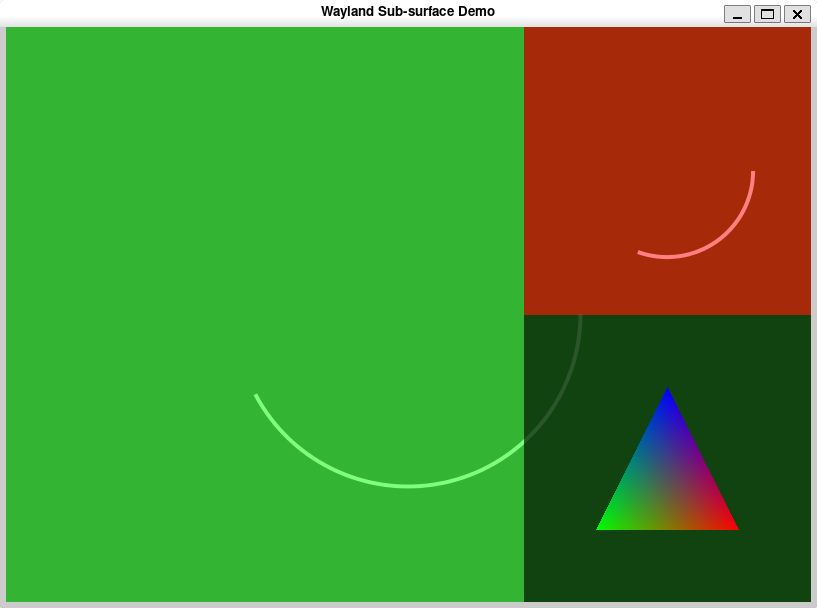
Weston provides demos like this one, which tests subsurfaces.
We talked a lot about language when we looked at X11. The situation is much better on Wayland. "Subsurface" is a nice name for what the objects intend to do and specific enough to not take away generic names from other concepts like the parent-child relation of the global window tree in X11 did.
But the Wayland specs and by that also other documentation luckily still uses that metaphor of a parent with children when describing subsurfaces. So to understand them we can think in that terminology without hesitation.
For more information about subsurfaces read on either the well-written descriptions in the core protocol or the subsurfaces chapter of the Wayland book linked above. If you are new to Wayland development though you should rather start with reading up on Wayland surfaces.
 Toplevel Children and Foreign Surfaces
Toplevel Children and Foreign Surfaces
We said toplevel windows on X11 are windows that are direct children of the root window.
For an X11 window manager these windows are the only ones of importance. These are the windows it may move, resize and in general whose state it manages, while it does in general not care about all other windows. And as noted these other windows are, per definition, children of some of these toplevel windows or the root window itself.
In this light for Wayland the xdg-shell protocol extension provides with the xdg-toplevel type very similar objects. These objects behave like the toplevels in X11, as in the Wayland window manager may move and resize them on user input or following other events.
And while subsurfaces are the spiritual successors of the classical parent-child relation of X11, setting a parent on an xdg-toplevel object reminds us of the previously discussed transient windows.
Here as before with transient windows we establish relations between windows of the same kind, as in the windows are independent toplevel windows. Like with transient windows the window manager is supposed to stack these windows relative to each other with one of them above the other.
Additionally there is the extension xdg-foreign-unstable-v2, which allows setting the relation across process boundaries. This is important for example for Flatpak apps and other sandboxed applications. It builds though upon the parent-child relation in the xdg-shell protocol. Thanks to Simon Ser for pointing this out!
Coming quickly back to the discussion about terminology,
it is great to see that the request in xdg-shell
to establish a parent-child relation between xdg-toplevels
is simply called set_parent.
And because of the object-oriented design of Wayland,
this name is not used up by that,
but we can still use it in other protocol extensions
when it makes sense.
In the case of the second protocol extension the adjective foreign is very descriptive about what the extension is meant for. And the document, which specifies the extension, keeps using the parent-child metaphor to describe its usage. This is also great, as it allows us to keep using our mental model.
What is not good
is that the request,
to set the child of a parent surface,
is called set_parent_of.
I wouldn't be surprised
if the name was inspired by the ominous "transient for" construct.
Old habits die hard.
But in the next version of that protocol
let us call that request just set_child, ok?
You might ask now: but what about group transients? I am happy to tell you, they are not a thing on Wayland.
 One Last Thing: Pop It!
One Last Thing: Pop It!
There is one more type of child window on Wayland, which should get mentioned but does not have a direct equivalence on X11: popups, usually in the form of context menus.
On Wayland these can be realized with the xdg-shell protocol extension providing the xdg-popup type.
Now you might say: "Wait a minute, context menus are also a thing on X11!" That's true, but on X11 they are not really child windows of anything more than the root window. They are placed by the client directly in global coordinates and superimposed by the X Server as override redirect windows. The window manager just ignores them.
On Wayland that is different, because for one the window manager is the server and secondly clients can not place surfaces in global coordinates.
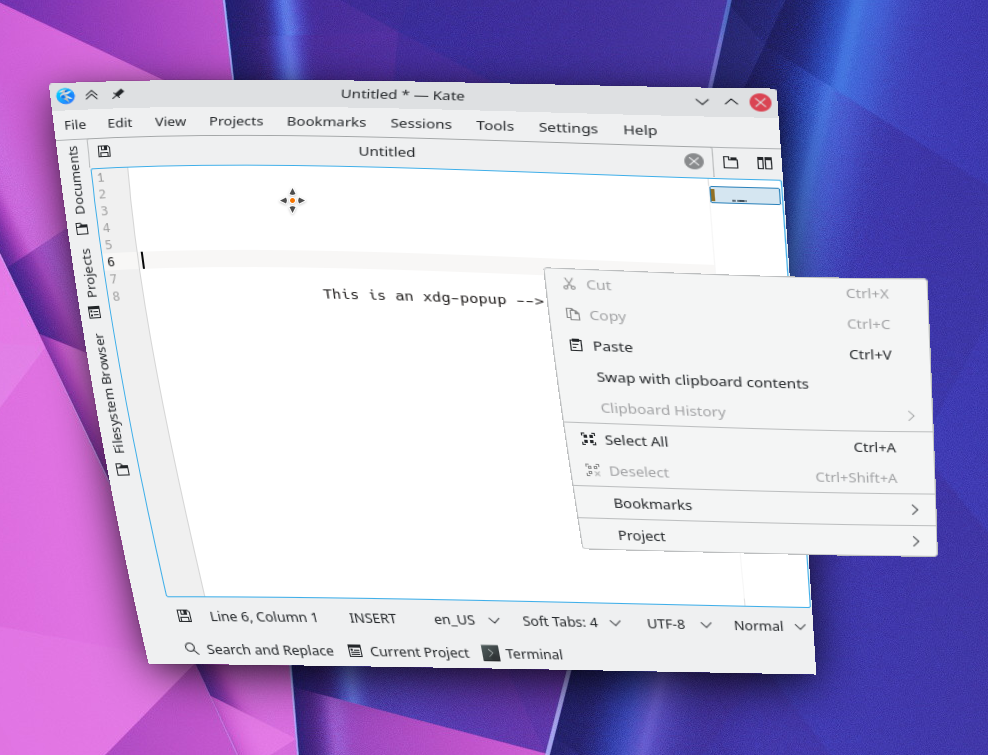
Wayland popups are placed and can be moved by the compositor, here together with the infamous wobbly windows effect.
A popup must therefore be placed relative to some other surface the client knows about. For example a right-click context menu will be opened directly at the position of the cursor. A hamburger menu opens relative to the visual boundaries of the hamburger button.
The xdg-shell protocol provides means to allow such initial placement and later correction. Admittedly that can become complex pretty quickly.
The important fact to remember though, is that on Wayland the xdg-popup type also establishes a parent-child relation with another window as its parent, while popups on X11 did not.
 Recap and Next
Recap and Next
In this introduction we took a tour through our "Window Kindergarten". We learned about the different kinds of window children by looking at their basic definitions in the X11 protocol and other X specifications and in the Wayland protocols with its extensions. We also mentioned for each of them what their use case is.
The mental model of window children and parents is powerful and transcends the mere technicalities of each individual protocol. Due to historic circumstances or just inexperience in developing intuitive terminologies, these fundamental ideas are sometimes more difficult to understand than necessary. Luckily this has improved with Wayland.
There seem to be two complementary basic types of children:
- As part of some tree structure, either a global one with a single root window or multiple outgoing from different windows.
- Via a direct connection linking windows of similar type that otherwise would not be connected via that tree structure.
Additionally we have on X11 need for a more complex implementation because of group transients while on Wayland subsurfaces and foreign surfaces are more straightforward. On the other side on Wayland the window manager needs to take over some work for subsurfaces, what was in the past handled by the X Server.
So we learned quite a lot about child windows. In the upcoming article, that is targeted to be published next week, we use our knowledge to take an in-depth look at the recent innovations in KWinFT, when handling X11 transients, Wayland subsurfaces and foreign surfaces in a unified way.
 Roman Gilg
Roman Gilg